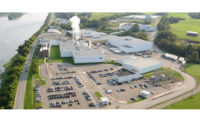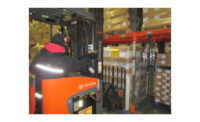A new way to clean revolutionizes a French fry plant
Ultrasonic cleaning technology helps a Canadian frozen foods processor save on production costs.

The Omegasonics Pro Plus ultrasonic cleaner at the Cavendish Farms plant deep cleans old and new components on a regular basis.Source: Omegasonics.
To produce frozen French fries, Cavendish Farms uses intricate machinery that requires regular cleaning and maintenance to decrease downtime and increase efficiency. In its New Annan potato processing plant on Canada’s Prince Edward Island, the process required to maintain its technology was lengthy and cumbersome. Scales, shakers, vibrators, graders, baggers, open bag detectors, metal detectors, case packers, sortation conveyors, palletizers, wrappers, gear boxes, ceiling cooling units and stainless steel filters all require regular cleaning and repairs.
Oil from the French fries clogs pivot points and other components, including parts that are more complicated to clean and maintain. Each of the plant’s 12 Ishida scales has 28 buckets—14 pool hoppers and 14 weigh hoppers. It can take up to four hours every few months to disassemble one bucket, hand scrub each component and reassemble and replace the unit. Oil also can cause errors on the scales and other malfunctions, including errant fries in the machinery.
Chris Keough, packaging maintenance supervisor at Cavendish Farms’ New Annan plant, realized an alternative cleaning process was in the company’s best interest. One weekend, he watched an ultrasonic machine clean a set of golf clubs, and he got an idea. A few months later, an Omegasonics 33-gallon Pro Plus industrial unit was on the plant floor. “Our ultrasonic system has completely changed how we do things,” says Keough.
The plant has realized the benefits of the system in several areas including labor efficiency and time savings. Before installing the system, the regular maintenance task list, on top of emergency repairs, was so time consuming for his mechanic that maintenance was continuously backlogged. The ultrasonic unit has reduced cleaning time by more than 85 percent.
Previously, it took not only four hours to clean one of the Ishida bucket scales, it required a skilled mechanic to do it. Now, a staff member, not a mechanic, can clean eight scales in four hours. The plant floor worker simply puts the scale into the ultrasonic unit and leaves it largely unattended while it does its job.
“I can’t emphasize enough the amount of time the ultrasonic unit has freed up for my mechanic,” says Keough. “We purchased it in June 2014, and we can actually see the light at the end of the tunnel on our backlogged maintenance list. We’re running cleaner, better equipment and using fewer man hours to do it.”
With less time spent on cleaning, old and new components are getting deep cleaned on a regular basis, increasing their performance and efficiency. For example, vibrators used on the plant’s processing line contain fibers with only .02 inches between them. Over time, these spaces fill up with dirt and grime, deadening their vibration and ultimately decreasing production efficiency. The fibers and the spaces between them were nearly impossible to clean by hand. But, ultrasonic cavitation bubbles reach into these intricate crevices and thoroughly clean the delicate fibers and all adjoining components, decreasing maintenance time and increasing productivity.
Looking for a reprint of this article?
From high-res PDFs to custom plaques, order your copy today!








